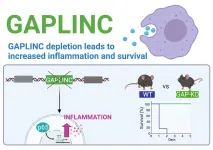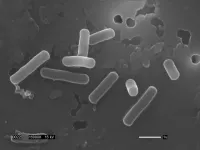COVID-19 intensive care mortality in Sweden lower than in many studies from other countries
Study also found mortality was driven by age, severity of disease and the presence and extent of organ failure, rather than mainly due to underlying conditions
2021-02-02
(Press-News.org) New research reveals that the COVID-19 intensive care (ICU) mortality rate in Sweden was lower during the first wave of the pandemic than in many studies from other countries. And while analysis of individual underlying conditions found they were linked to mortality, an analysis looking at all these variables together found COVID-19 mortality in intensive care was not associated with underlying conditions, except for chronic lung disease. This new study did, however, find that, like previous research, mortality was driven by age, severity of COVID-19 disease and the presence and extent of organ failure.
The study is published in the European Journal of Anaesthesiology (the official journal of the European Society of Anaesthesiology and Intensive Care [ESAIC]) and is by Dr Michelle Chew, Linkoping University Hospital, Linkoping, Sweden, and colleagues.
"Coupled with what is widely perceived to be a 'relaxed' national pandemic strategy, results for ICU care in Sweden are understandably under scrutiny," explain the authors.
They analysed 1563 adult admissions to Swedish ICUs from 6 March-6 May, 2020 with laboratory confirmed COVID-19 disease, and complete 30-day follow up, and found 30-day all-cause mortality was 27%, while mortality actually within ICU was 23%, indicating the most patients who died after requiring ICU treatment actually died within ICU.
Various factors including age were associated with mortality. Being male raised the risk of death by 50%, while having severe respiratory failure (more advanced disease -present in three quarters of patients) trebled the risk of death. However, except for chronic lung disease (a 50% increased risk of death), the presence of comorbidities was not independently associated with mortality. Also of note that was that the degree of hypoxia (insufficient oxygen) was much higher in this Swedish cohort than those from other countries. Put another way, these Swedish patients were generally sicker upon entering ICU.
The ICU mortality of 23% in this Swedish study is between that found in two nationwide studies with small cohorts from Iceland and Denmark, at 15% and 37% respectively. It is lower than the mortality rate reported from a North American study (35%) and a French-Belgian-Swiss study (26-30%). These studies had nearly complete discharge data, meaning that most patients had survived and left ICU or sadly died there, with few patients still being treated at the time of the study.
In one report from Lombardy, Italy, ICU mortality was initially reported to be 26%; however this did not contain complete data as many patients were still being treated. A later study consisting of mostly the same patients and with almost complete ICU follow-up, mortality was 49%. These results are comparable to a recent meta-analysis of 20 studies worldwide (TM Cook and colleagues, Anaesthesia, 2020) that reported an ICU mortality of 42% for patients with completed ICU admissions and discharge data. Another study by Cook and colleagues, being published in Anaesthesia at the same time as this Swedish study (see separate press release) shows global ICU mortality up to October 2020 has since dropped further to 36%.
This new study from Sweden confirms previous findings that mortality rates are significantly higher among those aged 65 years and older. Patients over 80 years of age were seven times more likely to die than those aged 50 years and under, although the authors make clear that their data "demonstrate that provision of intensive care should not be restricted on the basis of age alone". They add: "Not all over 80 year olds die in ICU, which is one reason why we cannot exclude this group of patients from ICU care based on age alone. All decisions on care must be taken on a patient-by-patient basis".
As in other studies, a majority of patients suffered from underlying conditions (comorbidities), most commonly high blood pressure, diabetes and obesity. Whilst most comorbidities were associated with death when analysed separately, their effects were not statistically significant after adjustment for other variables. Severe obesity (BMI>40) was not associated with increased mortality as suggested by other studies. The only underlying condition that was found to have an effect in Swedish patients was chronic lung disease, which was associated with a 50% increased risk of death.
The authors discuss the various aspects of the Swedish ICU policy that could be connected with the lower ICU mortality rate. They say: "We believe that process and organisational factors have likely contributed to the relatively good outcomes seen in Swedish ICUs as staffing, protective equipment, availability of drugs, medical and technical equipment were considered at an early stage at hospital and regional levels."
In the first quarter of 2020 Sweden had 5.1 ICU beds per 100,000 population, compared to 27/100,000 in the USA. The COVID-19 pandemic unleashed a coordinated response in Swedish ICUs doubling the number of beds from around 500 to more than 1100 at its peak. The proportion of occupied ICU beds in the country during the study period (the peak months of the first wave of the pandemic) never reached maximum capacity. Other factors potentially connected to lower COVID-19 ICU mortality are that anaesthesiology and intensive care are combined specialities in Sweden, and this dual competency enabled rapid diversion of resources from perioperative care to intensive care management.
However, Sweden's strategy has faced harsh criticism at home and abroad for being too relaxed and dependent on individual responsibility of citizens rather than enforced lockdowns. Sweden's King also, in late 2020, publicly criticised the country's COVID-19 strategy as a failure. New laws on public transport and gatherings were enacted in autumn 2020 to limit the rising spread of SARS-CoV-2, and in late 2020, the Swedish Government passed new laws in order to be able to enforce restrictions such as venue closures to prevent cases raging out of control. Future staffing shortages, the looming possibility of burn-out and numerous organisational challenges also remain.
The authors conclude: "Mortality rates in COVID-19 patients admitted to Swedish intensive care units are generally lower than previously reported in other countries despite more severe illness on admission among Swedish patients. Mortality appears to be driven by age, baseline disease severity, and the presence and degree of organ failure, rather than pre-existing comorbidities."
Professor Chew, who is also the deputy editor-in-chief of the European Journal of Anaesthesiology, adds: "Although Sweden chose a different pandemic strategy to its European neighbours, its population has not been immune to rising infection rates this winter. Only time will tell if the Swedish health care system can sustain the long-term burden of COVID-19 disease."
INFORMATION:
ELSE PRESS RELEASES FROM THIS DATE:
2021-02-02
Astronomers from the ARC Centre of Excellence for Gravitational Wave Discovery (OzGrav) and CSIRO have just observed bizarre, never-seen-before behaviour from a 'radio-loud' magnetar--a rare type of neutron star and one of the strongest magnets in the Universe.
Their new findings, published today in the Monthly Notices of the Royal Astronomical Society (MNRAS), suggest magnetars have more complex magnetic fields than previously thought - which may challenge theories of how they are born and evolve over time.
Magnetars are a rare type of rotating neutron star with some of the most powerful magnetic fields in the Universe. Astronomers have detected only thirty of these objects in and around the Milky ...
2021-02-02
HOUSTON-(Feb. 1, 2021) - Houston Methodist researchers have developed a mathematical model to predict how specific cancers will respond to immunotherapy treatments, thus enhancing chances for successful treatments from a wide variety of cancer-immunotherapy drug combinations. The results were published last month in Nature Biomedical Engineering in collaboration with researchers at MD Anderson Cancer Center.
Immunotherapy activates patients' immune systems to recognize and attack their cancers, leading to higher, more targeted kill rates and fewer side effects than chemotherapy, radiation and other therapies. While this technology is a significant advance in fighting cancer, it works only with some cancer ...
2021-02-02
Oak Brook, IL - The February edition of SLAS Discovery is a Special Issue on Hit Discovery Methodologies edited by Mark Wigglesworth, Ph.D., (Medicines Discovery Catapult, Stockport, EN, UK) and Peter Hodder, Ph.D. (Amgen, Thousand Oaks, CA, USA).
The focus of this Special Issue is to highlight the use of hit discovery methodologies and technologies and their usage in both small molecule and large molecule drug discovery. The February issue exemplifies how technologies, both new and existing, have been applied successfully to find hits.
Additionally, the issue houses a list of the most downloaded articles from SLAS journals, many of which ...
2021-02-02
Las Vegas, Nev. (Monday, Feb. 1, 2021) - In the summer of 2019, Desert Research Institute (DRI) scientist Rosemary Carroll, Ph.D., waited for the arrival of the North American Monsoon, which normally brings a needed dose of summer moisture to the area where she lives in Crested Butte, Colo. - but for the fourth year in a row, the rains never really came.
"2019 had just a horrendous monsoon," Carroll said. "Just the weakest monsoon. And we'd had a few years of weak monsoons before that, which had really gotten me wondering, how important is the monsoon to late summer streamflow here in the Upper Colorado River basin? And how do monsoons influence the following year's streamflow?"
Working in partnership with colleagues ...
2021-02-02
Oak Brook, IL - The February edition of SLAS Technology is a special collection of articles focused on "Artificial Intelligence in Process Automation" by Guest Editor Cenk Ündey, Ph.D. (Amgen, Thousand Oaks, CA, USA).
This SLAS Technology special collection targets the use of artificial intelligence (AI) techniques and technologies as applied specifically to drug discovery, automated gene editing and machine learning. As AI becomes increasingly more prevalent in research, medicine and even everyday life, laboratory automation has gone beyond hardware advancements toward new levels ...
2021-02-01
Risk for a severe form of retinopathy of prematurity, which can cause blindness in extremely premature babies, was halved when the newborns were given a new supplement combining various fatty acids. This was shown in a Swedish study led from the University of Gothenburg.
The study, now published in JAMA Pediatrics, is described as groundbreaking in its field. It documents a clear fall in retinopathy of prematurity (ROP) among extremely premature (EP) infants (born before 28 weeks' gestation), whose retinal blood vessels are not fully developed. The condition can cause ...
2021-02-01
When the body's immune response to an infection gets out of control, the result can be sepsis, a life-threatening condition in which an overwhelming inflammatory response can lead rapidly to failure of multiple organs and death.
In a new study, researchers at UC Santa Cruz have identified a long noncoding RNA (lncRNA) molecule that regulates the expression of pro-inflammatory genes in immune system cells called macrophages and affects the susceptibility of mice to septic shock.
This lncRNA, called GAPLINC, was previously studied for its role in cancer, but it turns out to be the most highly expressed lncRNA in macrophages, which play a central role in inflammation. ...
2021-02-01
A previously unknown root trait allows some cereal plants to grow deeper roots capable of punching through dry, hard, compacted soils, according to Penn State researchers, who suggest that harnessing the inherited characteristic could lead to crops better able to deal with a changing climate.
"This discovery bodes well for American and global agriculture because the trait helps corn, wheat and barley grow deeper roots, which is important for drought tolerance, nitrogen efficiency and carbon sequestration," said Jonathan Lynch, distinguished professor in plant science. "Breeding for this trait should be helpful in developing new crops for climate mitigation."
Called multiseriate cortical sclerenchyma by the researchers -- or MCS -- the phenotype is ...
2021-02-01
New research from North Carolina State University reveals that probiotic Lactobacillus bacteria use enzymes situationally to manipulate bile acids and promote their own survival in the gut. These findings further elucidate the complicated relationship between bile acids and gut bacteria and could eventually enable researchers to design lactobacilli with therapeutic properties, thereby engineering a healthier human gut environment.
Bile acids are key players in digestion and overall gut health. Produced in the liver and released after we eat, these acids not ...
2021-02-01
Just as plants and animals on land are keenly attuned to the hours of sunlight in the day, life in the oceans follows the rhythms of the day, the seasons and even the moon. A University of Washington study finds the biological light switches that make this possible.
Single-celled organisms in the open ocean use a diverse array of genetic tools to detect light, even in tiny amounts, and respond, according to a study published Feb. 1 in the Proceedings of the National Academy of Sciences.
"If you look in the ocean environment, all these different organisms have this day-night cycle. They are very in tune with each other, even as they get moved around. How do they know when it's day? How do they know when it's night?" said lead ...
LAST 30 PRESS RELEASES:
[Press-News.org] COVID-19 intensive care mortality in Sweden lower than in many studies from other countries
Study also found mortality was driven by age, severity of disease and the presence and extent of organ failure, rather than mainly due to underlying conditions






